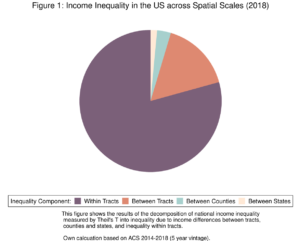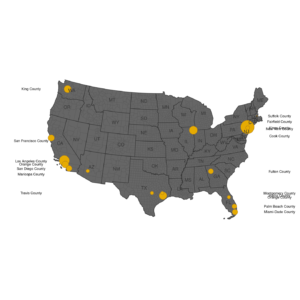This blog was written for the RSA Blog Student Summer Series that will highlight graduate student success in regional studies across the globe throughout the summer.
Inequality is a broad concept. Over the last few decades, different disciplines and research fields have come up with distinct interpretations and concepts to reveal, track, explain, and address inequalities. My co-author and I both have backgrounds in economics and as we started to get interested in the geography of inequality, we were surprised by the strong (conceptual) separation between efforts to make sense of inequality within countries or regions and research interested in inequality between regions at different spatial scales. In this post, we present first results of our project aiming to reconcile these perspectives.

In the case of income inequality, the economics literature is predominantly interested in inequality within countries. To get a sense of the extent of inequality, economists employ single national-level indicators. Prominent examples are the Gini-Index and the share of incomes going to the top 1 percent. This approach has illustrated the rapid increase of income inequality experienced by many countries and advanced our knowledge on how economic and socio-political processes shape inequalities within countries. However, it conceals important aspects of the underlying (national) income distributions. The geographic variation in income inequality across sub-national scales is a major aspect in this regard.
The regional inequality literature, on the other hand, is interested in inequality between regions at various spatial scales. Research in this field asked whether regions have become more similar over time or not. While work in this area spotlights differences in mean incomes between regions and unravels which regions contribute most to levels and trends in income inequality, it tends to ignore the distribution of income within the regions.
In our ongoing research project, we attempt to establish the connection between inequality within and inequality between regions. We offer a framework for the study of the geography of income inequality that enables us to learn which spatial scales and regions shape and share national level inequality trends. In what follows, we sketch that methodological setup as we apply it to income inequality in the United States, and we present selected preliminary results that we consider particularly interesting and important.
Beyond the Gini and the mean
We start by employing tract-level data of the 5-year vintages of the American Community Survey (ACS) for the period 2010 to 2018. We rely on the 16 brackets of total annual household income that are available for each tract in each year. These provide the number of households within each of the brackets that range from “less than $ 10,000” to “200,000” or more”. By applying recently developed Generalized Pareto Curve estimation, we recover the full income distribution for each tract in each year while adjusting for top incomes that are missing in the survey. These full income distributions allow us to estimate any inequality indicator of interest. As previous research on regional income inequality in the US was shaped, and to some extent restricted, by the few inequality measures (the Gini coefficient and the coefficient of variation) being published by the Census Bureau, this constitutes a major advantage in comparison to earlier work.
An inequality indicator that is particularly appealing for our application is Theil’s T. This index allows us to express national level income inequality in the United States as the sum of inequality between states, between counties, between tracts, and within tracts. Within tract inequality, at the same time, is inequality among all the households living therein.
Three realities of income inequality dynamics in the United States

The US has seen a notable increase in income inequality between 2010 and 2018, a period in which the Theil’s T index increased from 0.459 to 0.485. But this national experience was shared by few regions. For instance, only 6% (4,300) of the tracts have had a level of income inequality similar to US wide inequality in 2010, while less than 1% of tracts (670) have shared the increase in income inequality that happened to the country over that period.

Furthermore, we find that income inequality is driven by inequality within tracts both within a single year and over time.
75-78% percent of national income inequality measured in a single year is due to incomes being unevenly distributed within tracts, another 15% are due to income differences between census tracts (see Figure 1). The increase in national level income inequality between 2010-2018 was predominantly driven by increasing inequality within tracts. The impact of changes in inequality between tracts is comparably low (see Figure 2). We find substantial variation in income inequality across the US and we reveal that this arises at very small spatial scales.
We also investigate which and how many tracts drive national level income inequality. Our results suggest that between 2010 and 2018 one half of the 71,320 tracts have experienced neither an increase in income inequality nor an increase in mean income. It is only a small number of tracts, roughly 1.5% of them, that drive US inequality up (The map below shoes where most of them are located). Had income inequality remained stable in this small number of tracts, there would have been no increase in national level income inequality at all. However, there is a similar number of tracts that act as strong equalizers of national level inequality. Had inequality not decreased in these tracts, the increase in income inequality of the US would have been twice as high as it was.


Franziska Disslbacher (Twitter @f_disslbacher) is a PhD candidate at the Institute for Economic Geography at Vienna University of Economics and Business (WU) where she is also affiliated with the Research Institute Economics of Inequality (INEQ). Franziska works at the intersections of Economic Geography, Labor Economics and Public Economics. Her PhD thesis studies the measurement and geography of income inequality and intergenerational mobility. She is teaching Spatial Economics and Economics of Inequality at WU. Contact: franziska.disslbacher@wu.ac.at

Mathias Moser is Assistant-Professor (Post-Doc) at the Institute for Economic Geography at Vienna University of Economics and Business and the Research Institute Economics of Inequality (INEQ).
Are you currently involved with regional research, policy, and development? The Regional Studies Association is accepting articles for their online blog. For more information, contact the Blog Editor at rsablog@regionalstudies.org.